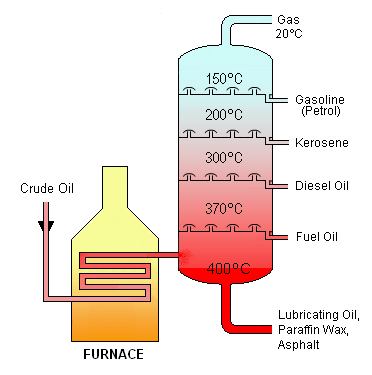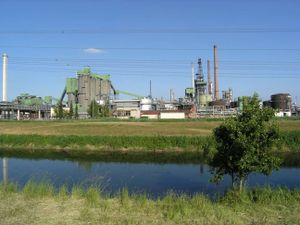Oil refinery
2007 Schools Wikipedia Selection. Related subjects: Business
An oil refinery is an industrial process plant where crude oil is processed and refined into useful petroleum products, such as gasoline and diesel fuel.
Operation

Raw oil or unprocessed ("crude") oil is not very useful in the form it comes in out of the ground. Although "light, sweet" (low viscosity, low sulfur) oil has been used directly as a burner fuel for steam vessel propulsion, the lighter elements form explosive vapors in the fuel tanks and so it is quite dangerous, especially so in warships. For this and many other uses, the oil needs to be separated into parts and refined before use in fuels and lubricants, and before some of the byproducts could be used in petrochemical processes to form materials such as plastics, and foams. Petroleum fossil fuels are used in ship, automobile and aircraft engines. These different hydrocarbons have different boiling points, which means they can be separated by distillation. Since the lighter liquid elements are in great demand for use in internal combustion engines, a modern refinery will convert heavy hydrocarbons and lighter gaseous elements into these higher value products using complex and energy intensive processes.
Oil can be used in so many various ways because it contains hydrocarbons of varying molecular masses, forms and lengths such as paraffins, aromatics, naphthenes (or cycloalkanes), alkenes, dienes, and alkynes. Hydrocarbons are molecules of varying length and complexity made of only hydrogen and carbon atoms. Their various structures give them their differing properties and thereby uses. The trick in the oil refinement process is separating and purifying these.
Once separated and purified of any contaminants and impurities, the fuel or lubricant can be sold without any further processing. Smaller molecules such as isobutane and propylene or butylenes can be recombined to meet specific octane requirements of fuels by processes such as alkylation or less commonly, dimerization. Octane grade of gasoline can also be improved by catalytic reforming, which strips hydrogen out of hydrocarbons to produce aromatics, which have much higher octane ratings. Intermediate products such as gasoils can even be reprocessed to break a heavy, long-chained oil into a lighter short-chained one, by various forms of cracking such as Fluid Catalytic Cracking, Thermal Cracking, and Hydrocracking. The final step in gasoline production is the blending of fuels with different octane ratings, vapor pressures, and other properties to meet product specifications.
Products of oil refineries
- Asphalt
- Diesel fuel
- Fuel oils
- Gasoline
- Kerosene
- Liquid petroleum gas (LPG)
- Lubricating oils
- Paraffin wax
- Tar
Safety and environmental concerns
Oil refineries are typically large sprawling industrial complexes with extensive piping running throughout. The refining process releases numerous different chemicals into the atmosphere; consequently, there are substantial air pollution emissions and a notable odour normally accompanies the presence of a refinery. Aside from air pollution impacts there are also wastewater concerns, upset risks of fire and explosion, and both occupational noise and environmental noise health effects.
The public has demanded that many governments place restrictions on contaminants that refineries release, and most refineries have installed the equipment needed to comply with the requirements of the pertinent environmental protection regulatory agencies. In the United States, there is strong pressure to prevent the development of new refineries, and no major refinery has been built in the country since Marathon's Garyville facility in 1976. However, many existing refineries have been expanded during that time. Environmental restrictions and pressure to prevent construction of new refineries have also contributed to rising fuel prices in the United States.
Environmental and safety concerns mean that oil refineries are sometimes located some distance away from major urban areas. Nevertheless, there are many instances where refinery operations are close to populated areas and pose health risks such as in Tenerife, Spain , which is sited in a densely-populated city centre and next to the only two major evacuation routes in and out of the city. In California's Contra Costa County and Solano County, a shoreline necklace of refineries and associated chemical plants are adjacent to urban areas in Richmond, Martinez, California, Pacheco, Concord, Pittsburg, Vallejo and Benicia, with occasional accidental events that require "shelter in place" orders to the adjacent populations.
Common process units found in a refinery
- Desalter Unit (washes out salt from the crude oil before it goes into the atmospheric distillation unit)
- Atmospheric Distillation Unit (distills crude oil into fractions)
- Vacuum Distillation Unit (further distills residual bottoms after atmospheric distillation)
- Naphtha Hydrotreater Unit (desulfurizes naphtha from atmospheric distillation. Must hydrotreat the naphtha before sending to a Catalytic Reformer Unit.)
- Catalytic Reformer Unit (contains catalyst used to convert the naphtha-boiling range molecules into higher octane reformate (reformer product). The reformate has higher content of aromatics, olefins, and cyclic hydrocarbons). An important byproduct of a reformer is hydrogen released during the catalyst reaction. The hydrogen is used either in the hydrotreaters and hydrocracker.)
- Distillate Hydrotreater Unit (desulfurizes distillate (diesel) after atmospheric distillation)
- Fluid Catalytic Cracking (FCC) Unit (upgrades heavier fractions into lighter, more valuable products)
- Hydrocracker Unit (upgrades heavier fractions into lighter, more valuable products)
- Coking unit (processes asphalt into gasoline and diesel fuel, leaving coke as a residual product)
- Alkylation unit (produces high octane component for gasoline blending)
- Dimerization Unit
- Isomerization Unit (converts linear molecules to higher octane branched molecules for blending into gasoline or feed to alkylation units)
- Steam reforming Unit (produces hydrogen for the hydrotreaters or hydrocracker)
- Liquified gas storage units for propane and similar gaseous fuels at pressure sufficient to maintain in liquid form - these are usually spherical or bullets (horizontal cylinder with rounded ends).
- Storage tanks for crude oil and finished products, usually cylindrical, with some sort of vapor enclosure and surrounded by an earth berm to contain spills
- Utility units such as cooling towers for circulating cooling water, boiler plants for steam generation, and wastewater collection and treating systems to make such water suitable for reuse or for disposal.
Specialty end products
These will blend various feedstocks, mix appropriate additives, provide short term storage, and prepare for bulk loading to trucks, barges, product ships, and railcars.
- Gaseous fuels such as propane, stored and shipped in liquid form under pressure in specialized railcars to distributors.
- Liquid fuels blending (producing automotive and aviation grades of gasoline, kerosene, various aviation turbine fuels, and diesel fuels, adding dyes, detergents, antiknock additives, oxygenates, and anti-fungal compounds as required). Shipped by barge, rail, and tanker ship. May be shipped regionally in dedicated pipelines to point consumers, particularly aviation jet fuel to major airports, or piped to distributors in multi-product pipelines using product separators called pipeline inspection gauges ("pigs").
- Lubricants (produces light machine oils, motor oils, and greases, adding viscosity stabilizers as required), usually shipped in bulk to an offsite packaging plant.
- Wax, used in the packaging of frozen foods, among others. May be shipped in bulk to a site to prepare as packaged blocks.
- Sulfuric acid finishing and shipping. This is a useful industrial material, usually prepared and shipped as the acid precursor oleum, a byproduct of sulfur removal from fuels.
- Bulk tar shipping for offsite unit packaging for use in tar-and-gravel roofing.
- Asphalt unit. Prepares bulk asphalt for shipment.
- Petroleum coke, used in specialty carbon products or as solid fuel.
Co-plant siting
Frequently a chemical plant will be sited adjacent to a refinery, utilizing intermediate products as feedstocks for the production of specialized materials such as plastics or agrichemicals.
History
The world's first oil refinery opened at Ploieşti, Romania in 1856 . Several other refineries were built at that location with investment from United States companies before being taken over by Nazi Germany during World War II. Most of these refineries were bombarded by the US Air Force in Operation Tidal Wave, August 1, 1943. Since then they have been rebuilt, and currently pose somewhat of an environmental concern.
Another early example is Oljeön, now preserved as a museum at the UNESCO world heritage site Engelsberg. It started operation in 1875 and is part of the Ecomuseum Bergslagen.
It is difficult to exactly state which is largest oil refinery in the world. At one time this was claimed to be Ras Tanura, Saudi Arabia, owned by Saudi Aramco. For most of the 20th century, the largest refinery of the world was that of Abadan in Iran. This refinery suffered extensive damage in the IRAN/IRAQ war. The Guinness Book of World Records now (October 2006) records the BP Amoco refinery in Texas City, USA, as the refinery with the largest capacity (433,000 barrels/day which is approximately 15,143,482 Imperial Gallon).
Early US refineries processed crude oil to recover the kerosene. Other products (like gasoline) were considered wastes and were often dumped directly into the nearest river. The invention of the automobile shifted the demand to gasoline and diesel, which remain the primary refined products today. Refineries pre-dating the EPA were very toxic to the environment. Strict legislation has mandated that refineries meet modern air and water cleanliness standards. In fact, obtaining a permit to build even a modern refinery with minimal impact on the environment (other than CO2 emmissions) is so difficult and costly that no new refineries have been built in the United States since 1976. As a result, the US is becoming more and more dependent on the imports of finished gasoline, as opposed to incremental crude oil.

